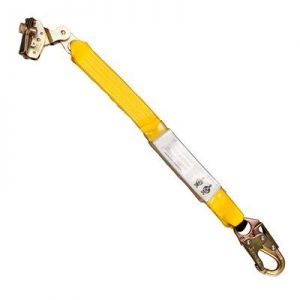Rope Grab: 6 fall protection tips from Hercules SLR
Rope Grab: 6 fall protection tips from Hercules SLR
Working at height? You have different options when it comes to connectors that aid in fall arrest and fall restraint—a rope grab is a popular option.
Rope grabs are a popular option because they’re often more cost-effective than SRLs (self-retracting lifelines), they allow for mobility in restraint situations, their lifeline length is longer and they can be used beyond the length of the longest SRLs.
Rope grabs are critical to many fall protection plans—read more to find out top six tips you need to know when using a rope grab.
Rope Grabs: top 6 tips
30” connectors are integral
CSA Z259.2.5-17 is a new CSA Standard that relates to rope grabs and certification for use. Users are required to use a 30” connector which is now integral to the unit. The new Standard tests for maximum arresting force (MAF) which is included in the scope of testing and most units will incorporate an energy absorber into the connector to meet that need.
6’ lanyards are not safe
Convention has dictated that 6-foot lanyards be used in fall arrest systems but in reality, this is very unsafe in the event of a fall on a rope grab.
When a 6-foot lanyard is used, the potential free fall on a trailing (automatic) rope grab can be 12 feet, which is considered a factor 2 fall. Using a regular energy absorber, the falling user would fall through the energy absorber and continue their fall into the backup lanyard, in essence, creating a second free fall. In certain cases where the lifeline isn’t matched to the rope grab, the potential for damaging the lifeline also exists. This would be considered a catastrophic failure that could lead to injury or death.
This is why it’s of the utmost importance to follow manufacturer instructions for lanyards. Manufacturers will outline the proper connector length limit, which is 30” in Canada and may differ elsewhere.
Rope grabs should always be matched to a lifeline – and tested!
We cannot overemphasize the importance of matching a rope grab with a proper lifeline and then testing it to ensure it will do its job in the event of a fall.
The testing process helps us verify a few important things:
- Mobility of the rope grab on the lifeline. This ensures the mobility is not jeopardized by the type, stiffness or flexibility of the lifeline which could prevent the rope grab from snagging and being pulled along during the climb of the user, causing a longer free fall.
- That the lifeline will survive the impact of a fall and allow the user the opportunity to be rescued. When a lifeline is broken during a fall, the odds of the user surviving the fall are low.
- The rope grab is compatible with the lifeline. Even though a lifeline might look another manufacturer’s lifeline, the yarn content within the rope of the lifeline may not be the same. Therefore properties of mobility, tensile strength and wear may not be the same and the rope grab might not function properly on it.
- That the lifeline is designed to be used as a lifeline. Polypropylene, or store bought yellow ropes do not function well as lifelines. They are not UV protected and tend to deteriorate quickly. They also “fur” and harden at an accelerated rate when compared to approved lifelines.
The difference between using a rope grab for fall restraint and fall arrest
In general, it is better to use a manual rope grab for fall restraint. This is because manual adjustment allows a lifeline to be set at a specific length with an appropriate setback from fall hazards. Trailing rope grabs, or automatic rope grabs, can often open/unlock (even while in the park feature) and allow the user to surpass the setback zone and enter a fall hazard area. Tying a knot in a lifeline to help locate a trailing rope grab is not an option. Doing so can reduce the strength of the rope by 50% and the strength loss is permanent. Undoing the knot does not restore lifeline strength.
Using a rope grab for fall arrest can be served by a manual or automatic unit, depending on whether or not vertical mobility is required. If vertical mobility is required, a trailing, or automatic, robe grab is ideal while a manual rope grab is better suited for when horizontally-oriented mobility is required in restraint.
Safe movement from lifeline to lifeline should be anticipated
In certain fall restraint applications, it’s important to understand the process of movement from one lifeline to another. If required, consider the following:
Plan the work zone so that users understand where the transfer points are and the process with which to proceed with the transfer.
The transfer point should be well back of any fall hazard and should provide an intermediate anchorage with which to make the change. Sometimes this will require the user to carry a second rope grab as part of their toolkit to complete the transfer from one lifeline to another.
Other transfer options many include: tying off to an anchor with a lanyard in order to facilitate the transfer from one lifeline to another. That lanyard can then be removed and the user can return to work.
Proper maintenance and storage is crucial
Like any tool, proper storage and maintenance of a rope grab is important to ensure the efficacy of the rope grab and the lifeline.
Rope grabs should be stored in a cool, dry place out of the sun and be kept away from dirt, grime, chemical contaminants and moisture.
When a rope grab is exposed to a dirty work environment, it is important to wipe it down with soapy water and leave it to air dry. This helps ensure that contaminants do not affect the operation of the rope grab and contaminate the rope channel.
Similar to rope grabs, lifelines must be keep clean and dry and stored in a similar environment. Grime and dirt in the yarn of a lifeline can cause breakdown, weakening or hardening of fibers, elongation and loss of strength. Chemical or debris contaminant will render the lifeline unusable, and it should be removed from service and replaced as this represents a failure during the inspection process.
——————————————————————————————————————————————
The Hercules Group of Companies encompasses a wide portfolio of products and services across 7 diverse companies.


